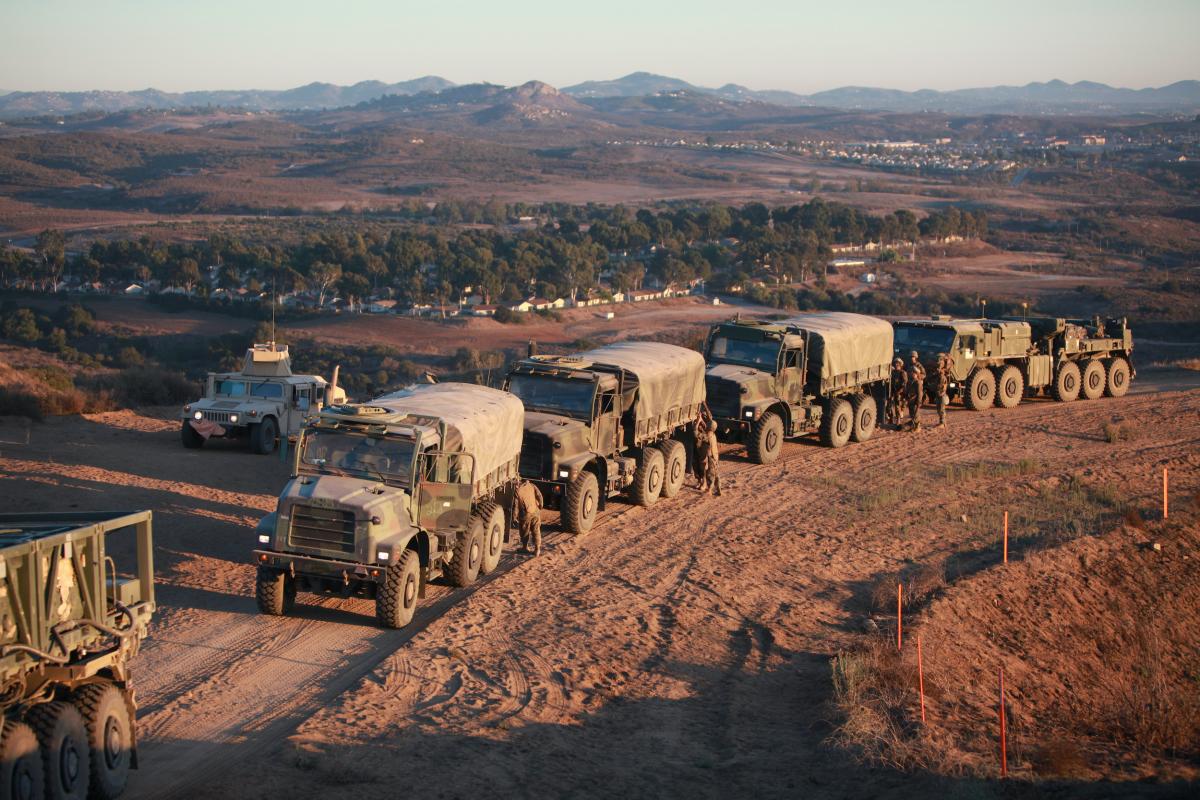Scientists have long known that aluminum is energy-dense and can create significant amounts of hydrogen when it encounters water. Normally, this hydrogen-producing reaction is blocked by “aluminum rust,” the shiny silver color people typically associate with aluminum cans. In 2018, a graduate student working at the Massachusetts Institute of Technology (MIT) accidentally discovered that aluminum could be “activated” or prevented from rusting if it was heated in the presence of very small amounts of gallium and indium, metals anyone can purchase online. This created a safe and efficient means of generating hydrogen on demand. If it can be done at scale, having Marine Corps units produce their own hydrogen fuel on the battlefield could revolutionize their logistics and simultaneously provide clear tactical benefits. In other words, Marines could “distill” their own “moonshine hydrogen” as a tactical fuel.
The Technology
The water and activated aluminum reaction produce three byproducts: hydrogen, heat, and aluminum hydroxide, the main ingredient in many antacid tablets. With funding from the Office of Naval Research, MIT undergraduates developed an aluminum-fueled BMW, powered a trolling motor for watercraft, a two-stroke engine that combusts the hydrogen, and a battery charger for dismounted infantry. One team used the hydrogen to raise large balloons with camera payloads into the stratosphere. One MIT student built a prototype water purification system that used the heat from the reaction to push water through a reverse-osmosis membrane—a process that typically requires diesel-powered reverse-osmosis water purification units. The aluminum feedstock used soda cans, household electrical wire, and BB-gun pellets.
Looking ahead, Marine Corps logisticians hope to simplify field messing by using the reaction’s heat and burning its hydrogen in standard military field stoves. Ground vehicles, watercraft, and unmanned aerial vehicles (UAVs) could all be driven with fuels cells powered by the reaction’s hydrogen byproduct and compressed into canisters using the reaction’s heat.
Contested Logistics
The biggest potential of using hydrogen for tactical applications is that it can be created at the point of use with a ready supply of water and “activated” aluminum. The future of expeditionary logistics will stress the logistics of fuel even farther. Commandant of the Marine Corps General David H. Berger has made it clear that “In the future operating environment, logistics will be the pacing function for the Marine Corps.” In 2019 the Deputy Commandant for Installations and Logistics went further, asserting that “Fuel is the pacing commodity.” However, the force has not identified clear solutions to the fuel logistics problems in the future operating environment.
In Force Design 2030, Berger also noted that “. . . we have identified the additional structure required to provide the tactical maneuver and logistical sustainment needed to execute DMO, LOCE and EABO . . .” and made it clear that logistics would be a focus of force design efforts in the future because it is essential to operationalize EABO and other future operating concepts. Operational energy is not just a challenge for the future, but a problem across all different types of operations. In his book Seapower, Geoffrey Till argues that even traditional amphibious operations “are often dominated” by logistics, particularly the logistics of fuel.1
Recent commentary on distributed logistics has made clear that the Fleet Marine Force is preoccupied with sustainment in the future fight. Proposals have run the gamut from narco-inspired semi-submersibles to Jack Ryan-esque logistics sleeper cells. However, those proposals assume that the Marine Corps will require the same classes of supply today as it will in the future fight. Shifting to aluminum-generated hydrogen fuel, or hydrogen electrolysis powered from an on-island power grid, would upend the entire logistics paradigm.
Today, the Defense Logistics Agency (DLA) purchases fuel for the military and stockpiles it around the globe. The supply chain is long and increasingly vulnerable. Even in relatively low-level conflicts, the military has been hamstrung by fuel supply problems.
Using hydrogen fuel cells and aluminum reactors, Marine Corps units will need only a ready supply of aluminum and water to meet their energy needs. Unlike petroleum, aluminum is widely available in the western Pacific and Southeast Asia, where the Marine Corps has begun to focus its force design efforts. When Marines and sailors can power their vehicles and charge their batteries with recycled aluminum from old soda cans or bicycles or junked cars, they will depend less on supply and make it more difficult for an enemy to cut them off. Experimentation with aluminum is also in line with the Commandant’s call for “radically reducing fuel consumption” and leaning into an “aggressive exploration of electric vehicles [and] alternative fuels…” In his senate confirmation hearing, former secretary of Defense Jim Mattis also called for the military to “explore alternate and renewable energy sources that are reliable, cost effective, and can relieve the dependence of deployed forces on vulnerable fuel supply chains…” which activated hydrogen aluminum fuel promises to be and do.
Using aluminum fuel also opens more opportunities for innovation in distribution and packaging. During the Falklands War, British forces were initially forced to move their fuel ashore and distribute it in thousands of jerry cans filled with hand pumps, and carry them from position to position by hand or helicopter.2 Aluminum, by contrast, could be distributed with other solid supplies or included in the packaging for dry goods like ammunition.
The ubiquity of aluminum also makes it possible to stockpile fuel in “politically benign caching.” A warehouse full of aluminum pellets does not send the same message to allies and partners as does a fuel farm of aviation gas next to a major runway. It is more environmentally safe, and it does not obviously support military activity, making it much less likely to be targeted by an adversary.
Tactical Benefits
Hydrogen has long been recognized as a promising alternative fuel source, but it never took off because hydrogen was expensive and inefficient to refine. The first hydrogen-powered vehicle was a converted GM Handivan in 1966. Today, new companies are vying to take advantage of the benefits of hydrogen propulsion and the growing commercial availability of hydrogen fuel.
Last year, Airbus revealed concept sketches of three hydrogen-fueled gas turbine and turboprop aircraft and announced it planned to have a hydrogen-powered commercial airliner by 2035. Toyota is on its second iteration of the Mirai, a commercially available sedan, and Honda offers the Clarity, its own hybrid-hydrogen sedan.On the water, Yanmar has teamed with Toyota to create a hydrogen-powered yacht while Alva Yachts advertises a hydrogen-powered vessel with 1,300 hp. Ski-Doo’s parent company now offers a hydrogen snowmobile.
For military applications, hydrogen fuel-cell technology offers significant advantages over internal combustion engines, especially for smaller units, with lower energy demands like reconnaissance units. Because hydrogen fuel-cells can be used to power electric drive trains, the military can reap the benefits of electric vehicles without the excessive weight and other issues posed by batteries. Electric drive trains are almost completely silent and produce a much lower thermal signature than combustion engines – key considerations for stand-in forces.
Hydrogen fuel cells can help the military realize long-time dreams of silent drive vehicles for infantry and reconnaissance applications. Hydrogen can also be used to generate electricity and end the use of noisy and fuel-hungry diesel generators to power computers and charge radio batteries.
One of the most exciting potential applications for hydrogen is in UAVs. The Naval Research Laboratory has already flown a hydrogen-powered UAV that had an endurance of more than 48 hours. Groups of mid-sized UAVs operating out of a hydrogen tactical refueling point (H-TaRP) can be essential to maintaining domain awareness during distributed operations and would no longer need to be tethered to a petroleum fuel supply.
Rapid hydrogen generation can also be used to fill lighter-than-air platforms. Surveillance balloons have been the longest military application of hydrogen, dating back to the Civil War. In prior conflicts, hydrogen provided the lifting gas for manned surveillance and artillery spotting missions. French factories produced tens of millions of cubic feet of hydrogen for use in 5,800 U.S. Army Air Service surveillance missions during the First World War. Existing commercially available stratospheric balloons provide the benefits of hydrogen-lofted surveillance balloons without putting aviators in harm’s way.
Safety
Hydrogen is often assumed to have a poor safety record because of its association with the Hindenburg disaster. Today, however, hydrogen is safe enough that it can be used in privately-owned vehicles. In many ways, it is safer than petroleum fuels. When a tank of compressed hydrogen is punctured, it vents vertically because hydrogen is lighter than air. If ignited, this creates a vertical jet of flame that is far less dangerous than the ones that can result from the same puncturing of liquid fuel tanks.
Shifting the Marine Corps to using hydrogen created from aluminum and water reactions at the forward edge of the battlefield can help enable distributed logistics and expeditionary advanced base operations. At the same time, it would improve tactical vehicle fleet capabilities by reducing vehicle signatures and improving their range. A full conversion from petroleum-based fuels to hydrogen could take decades, but the benefits are clear and private industry is already leading the way. The Marine Corps has no time to waste in leveraging this emerging technology to revolutionize logistics and improve lethality.
1. Geoffrey Till, Seapower: A Guide for the 21st Century, 3rd edition, (New York, NY: Routledge, 2013) 168.
2. Kenneth Privratsky, Logistics in the Falklands: A Case Study in Expeditionary Warfare, (Philadelphia, PA: Pen & Sword Books, 2014) 118–119.






